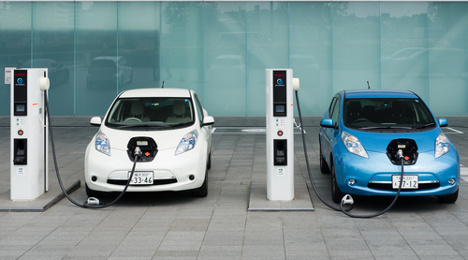Used-car impact of likely EV tax credit elimination

2015 photo of Nissan Leaf vehicles in Japan. Editorial credit: Joel_420 / Shutterstock.com
The elimination of federal tax incentives would mean a fender-bender, if not a more serious “crash,” in the electric vehicle market, according to a report released Friday by Edmunds.
And there certainly are some implications for the pre-owned side of the EV market.
Would a lack of a tax credit on the new EV side indirectly make the pre-owned electric vehicle more attractive and/or affordable?
“If tax credits were to go away (and there was no pick up in subsidy from states or the automakers themselves), price-sensitive EV buyers would be funneled into the secondhand market,” Edmunds executive director of industry analysis Jessica Caldwell said via email.
“As battery efficiencies improve, used EVs will become more attractive to consumers,” she said. “However, we are still in the early stage of this market and used buyers must be willing to sacrifice technology for a lower price tag.”
As far as the basics of the situation, Edmunds explained in its report that a federal tax credit of up to $7,500 has been available to buyers of qualified plug-in electric vehicles since 2010, and 200,000 of these credits were allotted to each electric vehicle maker.
Tesla and Nissan are roughly halfway through their credits, Edmunds said, with General Motors likely to exhaust its credits late next year or in 2019.
“Federal tax credits for EVs are a part of a broader set of EPA policies, which require congressional approval to adjust,” Edmunds explains in the report. “So the Trump administration may not eliminate them prematurely, but is unlikely to extend these credits. Without these credits, this market is likely to crash.”
The tax credits were not specifically addressed in Trump’s 2018 budget plan, but his proposal to wipe out the Department of Energy’s Advanced Technology Vehicles Manufacturing loan program would trip up a potential shot in the arm for EV production, Edmunds argues.
All told, if tax incentives were off the table, EV sales goals will be hard to reach, the company says.
“With gas prices at a relative low and the popularity of SUVs and trucks hitting all-time highs, the EV market is at a crossroads,” Caldwell said in a news release.
“While the high-end EV market most likely has the ability to hold steady, our analysis shows that the average car shopper still needs a significant financial incentive to choose an electric vehicle over a traditional counterpart,” she said.
Consider what happened on the state level in Georgia. The state was providing a $5,000 tax credit on zero-emission vehicles, and in 2014, 17 percent of all U.S. electric vehicle sales were from Georgia, according to Edmunds.
Then the incentive was dropped in July 2015.
The Peach State’s slice of the national EV sales pie went down to 2 percent.
“This crash was not uniform among all EVs. Sales of the Tesla Model S declined post credit elimination but bounced back to normal levels within a few months,” Edmunds said in the report. “Nissan Leaf sales, however, never rebounded after the credit elimination and are now at parity with sales of the Tesla Model S.”
Interestingly enough, 80 percent of EV sales in the state were leases, Edmunds said. And typically, EV leasing is quite reliant on tax credits due to the segment’s lower residual values, Edmunds said.
The technology moves so fast in the EV market that it creates more rapid depreciation and, thus, softer values in the used-car market.
Case in point: 2013 model-year Nissan Leaf vehicles had retained just 30.4 percent of their original MSRP by 2016, according to data from Edmunds. For the Chevrolet Volt, the retention was only slightly better (36.1 percent).
Comparatively, 3-year-old midsize cars had 56 percent retention in 2016, compact cars were at 59.6 percent, subcompact cars were at 60.6 percent and compact crossover SUVs were at 65.9 percent.
“The federal tax credit (along with credits offered by many states) create low purchase prices — particularly for leasing — which further decreases demand on the used-car side,” Edmunds explains. “Used vehicles do not present an attractive cost-saving alternative to new vehicles when leased.”
And lower used EV prices actually are a bad sign for the companies making the cars.
“The low used values are a problem for automakers because if the federal subsidy is lifted, lease payments will go up significantly due to low residual values,” Edmunds said. “Without advantageous pricing, the market would be further limited.”

 View The Latest Edition
View The Latest Edition

